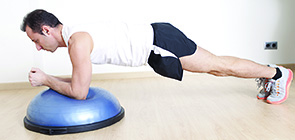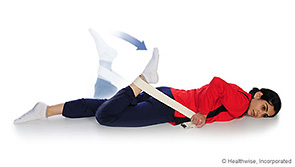
One of the popular topics in the fitness industry over the past few years has been “core stability”. This is not merely the next exercise fad. Core stability is considered essential for preventing injuries to the lumbar spine.
Core stability is a misunderstood term. Typically, “the core” is associated with the strength of the abdominal muscles. For the purpose of designing an exercise routine, we need to include the hip muscles, pelvic floor muscles and low back in our model of “the core”. The lumbar spine (low back) is primarily responsible for posture and providing stability for the muscle contractions used in our body’s movement patterns. The low back should be considered in the “core package” because it serves as an anchor for other muscles that create stable body movement patterns.
Whenever a body movement is initiated, the core muscles are tensed first. This forms a stable ball-like “core” region against which the mechanical forces of our movement patterns are balanced and coordinated with our body posture.
It is commonly accepted that core stability is essential for the maintenance of an upright posture. Without core stability, the low back is not supported internally, and therefore may be more prone to injury through strains caused by even mild exercise. A routine chiropractic assessment can help to determine which patients may be more pre-disposed to lumbar (low back) injuries due to exercise.
While core stability exercises assist in promoting safe movement patterns, they may not be necessary for all patients:
Studies suggest that core stability exercises may only produce the same benefits as general, non-specific exercise (Journal of Physiotherapy – 2008, 2009, Journal of Clinical Rehabilitation – 2006).
Another published study suggests that core stability exercises may only produce the same benefits as walking (Australian Journal of Physiotherapy – 2009).
Despite the fact that most elite sports training programs include core stability regimes, core stability exercises failed to demonstrate an improvement in sports performance (Journal of Sports Medicine – 2008).
While the published research may suggest that core stability exercises do not produce vastly superior results over general exercise programs, the introduction of a core stability exercise regime improves the strength and stability of the spine and spinal muscles.
Because chiropractic care places a strong focus on healthy spines, posture and efficient movement patterns, core stability exercises may enhance the benefits of receiving regular chiropractic treatment.
As a spinal specialist, your family chiropractor can provide you with simple, safe and non-strenuous exercises to strengthen your “core” and stabilise your spine.
Stretch of the Month
Quadriceps Stretch

- Using a towel, lie on your stomach.
- Attach the band your right foot and pull your heel to your butt.
- Hold this stretch for 1 min.
- Repeat 3 times.
- Change legs and repeat 3 times.
Towards Wellness
Natural Oils for Winter Skin
Natural oils are the ideal solution for winter skin problems. Not only do they provide moisture, but in their natural state, natural oils often contain anti-aging nutrients that can repair damaged skin and help prevent further damage. Some of these include:
- Coconut oil is probably the best known natural skin care oil. In addition to being a moisturising oil, it contains vitamin E and a molecule called squalene whose chemical structure closely resembles the skin’s sebum
- Shea butter forms a barrier between the elements and the skin and seals in moisture. Natural therapists also often recommend shea butter for its ability to help heal scar tissue produced by stretch marks and hyper-pigmentation.
- Argan oil Studies have shown that the scientific secret behind this beauty secret is the abundance of nutrients and antioxidants.
- Jojoba has some very distinguishing properties; one of them being that instead of producing a plant oil, it produces a wax ester that is nearly identical to skin sebum. Jojoba oil also contains antibacterial properties and high levels of antioxidants.

